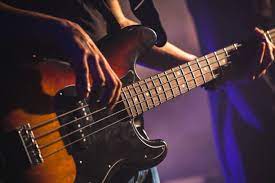Learning the bass neck is seen as something of a holy grail amongst bass players.
It’s somehow both a worthy and worthwhile quest but also impossible to complete.
There’s also a lot of disagreement about the best way to do it. Should you use exercises?
Should you try to constantly find stranger and stranger shapes to move around?
Well, today I’d like to add an approach into the mix.
Rather than trying to memorise an endless amount of shapes, what about learning the organisational principles behind the layout of the bass neck?
In short, is it possible to learn the bass neck as a way of thinking?
If this were possible we’d no longer have to memorise anything. Instead, we could explore and work things out on our own until they became locked into our memory and then became effortless for us to use.
The short answer is yes. It’s perfectly possible. You could argue that it’s even preferable and that it might make us actually understand the neck better.
Let me explain how with a few short stories about how I started learning the neck as a kid.
Principles Of The Neck
Like a lot of bass players, one of the very first things I was taught was how to tune a bass.
My teacher (the AWESOME Paul Cordell) showed me that if you played the fifth fret of one string and then played the open string above you’d get the same note if the bass was in tune.
It took me several years to have the following thought but eventually, I asked myself “does this mean that the 6th fret of one string and the 1st fret of the next are also the same?”. I was delighted to learn that they are.
I realised that this was a general rule or principle of the neck and it led me to discover that there was more than certain notes that were the same.
If I started a pattern like a triad in one place I could move it up a string and down five frets and the notes would be the same.
Fast forward several years later to being a keen student studying for a place at music school and my teacher (Rich Bennett) had begun teaching me about intervals.
I had a really hard time understanding what they were.
Why was E a major third up from C and not Eb?
Why was D to A a perfect 5th and not a 4th?
I asked Rich and he told me “it’s all about the principle. This shape (he demonstrated a minor third) is always a minor third”. He then preceded to show me all the other intervals.
This really clicked because learning a principle about the neck allowed me to not only think abstractly about the neck. I could also explore it too.
I could play all the intervals from one note to see what other notes came out. I could build different chord shapes and then move them around the neck using the first principle Paul Cordell had taught me.
If my memory serves me well then I think the correct term for what was happening is “comprehensible input”. This means having to understand something in order to use it and it’s something that humans are naturally very good at. We have to comprehend language in order to use it for example.
If we contrast this comprehensive focussed approach with the idea of simply having to memorize scale shapes we begin to see why simple memorization often doesn’t work.
Memorising Scale Shapes Doesn’t Work
Memorizing a scale shape, for example, doesn’t require us to understand the shape and the context that the shape exists in. Namely, the electric bass guitar neck.
In short, there’s nothing for us to comprehend.
And, to learn notes on bass guitar effectively, we need to comprehend the bass guitar fretboard.
Worse still is that this memorization actually facilitates very little learning. It’s a very similar process to learning pick technique, slap or fingerstyle technique in some sense.
Sure we could blast off a scale shape but we may not be able to use that shape to explore the neck.
One of the best examples I can give is also one of the most common.
Bass players who can play anything in bass-friendly keys like E, A, D or G are very common. We know these keys because it’s easy to play in them and because we often get taught scales, arpeggios and songs in them.
Where many bass players struggle is in keys like F, Bb, Eb or C#. Granted they don’t suit the instrument as well but the curious thing is in these keys and every other, scale shapes are the same as they are in E, A, D or G.
The shapes are the same going up a single string like the G string too.
And, thinking about bass guitar notes and scales this way means there are no difficult keys, no memory problems between natural notes and accidental notes or anything else.
So if we can memorize the shapes for the easy keys why do we struggle with the hard keys?
Because when we memorize, if we’re not careful, we do so at the expense of comprehension. We end up sacrificing our understanding.
Yes memorizing the bass neck is a never-ending quest but framing it as a quest implies that there’s a finish line. Some standard that we can reach where the task is complete.
This is a total myth.
Memorizing the neck misses the mark from the get-go. Personally, I feel the better approach is to understand the neck.
Understand how it’s laid out, how one shape can be moved from one position to another, comprehend how to move the same song into different keys and to understand the bass neck as a way of thinking rather than just a set of facts to be memorised.
I’m sure there will be folks out there who disagree with my approach. If you’re one of them then write to me and let me know. I’m always keen to discuss this with anyone I can.
But there’s no denying that the student who can better comprehend the instrument they play will be able to better explore it.
If you want a quick example of this approach in action then please check out this video I made showing how you can master the entire neck in all twelve keys with only three scale shapes.
Yes, it requires learning some principles and a little comprehension but trust me, it’s really worth it!


Leave a Reply